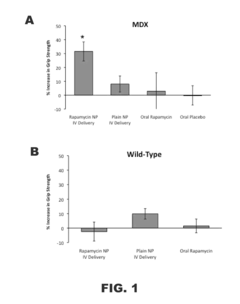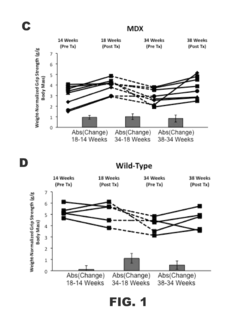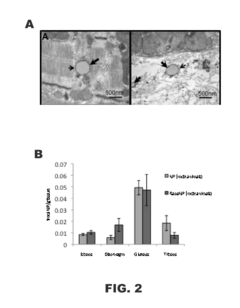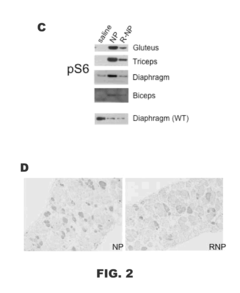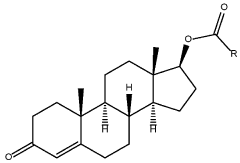Hypertonic Techniques in Optimizing Muscle Function
Hypertonic Techniques Background and Objectives
Hypertonic techniques have emerged as a promising field in the optimization of muscle function, drawing increasing attention from researchers and practitioners in sports science, rehabilitation, and performance enhancement. The evolution of these techniques can be traced back to the early studies on muscle physiology and the effects of osmotic pressure on cellular function. Over the past decades, the understanding of how hypertonic environments influence muscle performance has grown significantly, leading to the development of various applications in both clinical and athletic settings.
The primary objective of research in hypertonic techniques for muscle function optimization is to explore and harness the potential benefits of exposing muscles to hypertonic solutions or environments. This approach aims to enhance muscle strength, endurance, and recovery by manipulating the osmotic balance within and around muscle fibers. The underlying principle involves creating a controlled hypertonic state that can potentially improve muscle contractility, reduce fatigue, and accelerate post-exercise recovery.
As the field progresses, researchers are focusing on several key areas. One major thrust is the investigation of different hypertonic solutions and their specific effects on various muscle groups and types of physical activities. This includes studying the optimal concentrations, application methods, and timing of hypertonic interventions to maximize their effectiveness. Another important aspect is the exploration of the physiological mechanisms through which hypertonic techniques exert their effects, including changes in cellular hydration, ion transport, and metabolic processes within muscle tissue.
The technological advancements in measurement and analysis tools have significantly contributed to the progress in this field. High-precision imaging techniques, real-time physiological monitoring devices, and sophisticated data analysis methods now allow researchers to observe and quantify the effects of hypertonic techniques on muscle function at unprecedented levels of detail. This has opened up new avenues for understanding the intricate relationships between osmotic pressure, muscle fiber dynamics, and overall performance.
Looking ahead, the research in hypertonic techniques for muscle function optimization is expected to evolve towards more personalized and targeted approaches. The integration of genetic profiling, individual physiological characteristics, and specific performance goals may lead to tailored hypertonic protocols that can be fine-tuned for maximum efficacy in different individuals and scenarios. Additionally, the potential synergies between hypertonic techniques and other emerging technologies in sports science and rehabilitation present exciting possibilities for comprehensive muscle function enhancement strategies.
Market Analysis for Muscle Optimization Solutions
The market for muscle optimization solutions has experienced significant growth in recent years, driven by increasing health consciousness and the rising popularity of fitness activities. This trend is particularly evident in developed countries, where aging populations and sedentary lifestyles have led to a greater focus on maintaining muscle function and overall physical well-being.
The global market for muscle optimization products and services is projected to reach substantial value in the coming years, with a compound annual growth rate (CAGR) outpacing many other health and wellness sectors. This growth is fueled by a combination of factors, including advancements in sports science, the proliferation of fitness technology, and a growing awareness of the importance of muscle health in overall wellness.
One of the key drivers of market demand is the expanding demographic of health-conscious consumers. This group includes not only professional athletes and fitness enthusiasts but also older adults seeking to maintain their independence and quality of life through improved muscle function. The increasing prevalence of lifestyle-related diseases has also contributed to the demand for muscle optimization solutions, as maintaining muscle mass and strength is recognized as a crucial factor in managing conditions such as obesity and diabetes.
The market for hypertonic techniques in muscle optimization is particularly promising. These techniques, which involve the use of high-concentration solutions to enhance muscle performance and recovery, are gaining traction among both professional athletes and amateur fitness enthusiasts. The appeal of hypertonic solutions lies in their potential to improve muscle hydration, reduce fatigue, and enhance overall performance.
In terms of product segments, the market encompasses a wide range of offerings, including nutritional supplements, specialized training equipment, wearable technology for muscle monitoring, and professional services such as personalized training programs and physiotherapy. The nutritional supplement segment, which includes protein powders, amino acid supplements, and electrolyte solutions, holds a significant market share and is expected to continue its strong growth trajectory.
Geographically, North America and Europe currently dominate the muscle optimization market, owing to high disposable incomes, advanced healthcare infrastructure, and a well-established fitness culture. However, the Asia-Pacific region is emerging as a lucrative market, driven by rapid urbanization, increasing health awareness, and rising disposable incomes in countries like China and India.
The competitive landscape of the muscle optimization market is characterized by a mix of established multinational corporations and innovative startups. Key players are investing heavily in research and development to introduce novel products and technologies, with a particular focus on personalized solutions that cater to individual needs and preferences.
Current Challenges in Hypertonic Muscle Enhancement
Despite the promising potential of hypertonic techniques in optimizing muscle function, several significant challenges currently impede their widespread adoption and efficacy. One of the primary obstacles is the limited understanding of the precise mechanisms through which hypertonic solutions affect muscle tissue at the cellular level. While researchers have observed improvements in muscle performance, the exact pathways and long-term effects remain unclear, hindering the development of targeted and optimized protocols.
Another challenge lies in the variability of individual responses to hypertonic treatments. Factors such as age, fitness level, and genetic predisposition can significantly influence the effectiveness of these techniques, making it difficult to establish standardized protocols that work universally. This variability also complicates the process of conducting large-scale clinical trials and obtaining consistent, reproducible results.
The optimal composition and concentration of hypertonic solutions present another hurdle. Different electrolyte combinations and osmolalities may yield varying results, and determining the ideal formulation for specific muscle groups or performance goals remains a complex task. Moreover, the timing and frequency of hypertonic interventions in relation to exercise or competition are not yet fully understood, leaving room for potential misapplication or reduced efficacy.
Safety concerns also pose significant challenges in the field of hypertonic muscle enhancement. The potential for adverse effects, such as electrolyte imbalances, dehydration, or cardiovascular stress, necessitates careful monitoring and individualized approaches. Developing protocols that maximize benefits while minimizing risks requires extensive research and rigorous testing, which can be time-consuming and resource-intensive.
The integration of hypertonic techniques with existing training regimens and nutritional strategies presents another challenge. Determining how these interventions interact with other performance-enhancing methods and how they can be seamlessly incorporated into athletes' routines without disrupting established practices requires further investigation and practical experimentation.
Lastly, the regulatory landscape surrounding hypertonic techniques in sports and medical applications remains uncertain. The lack of clear guidelines and standardized protocols makes it challenging for practitioners to implement these methods confidently and for governing bodies to establish appropriate regulations. This regulatory ambiguity may slow down the adoption of hypertonic techniques in competitive sports and therapeutic settings.
Existing Hypertonic Techniques for Muscle Function
01 Hypertonic solutions for muscle function enhancement
Hypertonic solutions can be used to improve muscle function by altering the osmotic environment of muscle cells. These solutions can enhance muscle contraction, increase force production, and potentially improve overall performance. The technique involves applying or administering hypertonic solutions to muscles, which may lead to changes in cellular hydration and ion concentrations.- Hypertonic solutions for muscle function enhancement: Hypertonic solutions can be used to improve muscle function by altering the osmotic environment of muscle cells. These solutions can enhance muscle contractility, increase force production, and potentially improve overall performance. The technique involves applying or administering hypertonic solutions to muscles, which may lead to changes in cellular hydration and ion concentrations.
- Electromyographic analysis of muscle function under hypertonic conditions: Electromyography (EMG) can be used to assess muscle function in response to hypertonic techniques. This method allows for the measurement of muscle electrical activity and can provide insights into how hypertonic environments affect muscle recruitment patterns, fatigue, and overall performance. EMG analysis can be particularly useful in evaluating the effectiveness of hypertonic interventions on specific muscle groups.
- Hypertonic techniques for muscle recovery and rehabilitation: Hypertonic techniques can be applied in muscle recovery and rehabilitation protocols. These methods may involve the use of hypertonic solutions or environments to promote healing, reduce inflammation, and improve muscle function following injury or intense exercise. The application of hypertonic techniques in rehabilitation settings may help accelerate recovery times and enhance overall treatment outcomes.
- Combination of hypertonic techniques with other therapeutic modalities: Hypertonic techniques can be combined with other therapeutic modalities to enhance muscle function. This may include the integration of hypertonic solutions or environments with electrical stimulation, ultrasound therapy, or specific exercise protocols. The synergistic effects of these combined approaches could potentially lead to greater improvements in muscle strength, endurance, and overall function.
- Molecular mechanisms of hypertonic effects on muscle function: Research into the molecular mechanisms underlying the effects of hypertonic techniques on muscle function is ongoing. This includes investigations into how hypertonic environments influence ion channels, cellular signaling pathways, and protein expression in muscle cells. Understanding these mechanisms can lead to more targeted and effective applications of hypertonic techniques for improving muscle function in various contexts.
02 Electromyographic analysis of muscle function under hypertonic conditions
Electromyography (EMG) can be used to assess muscle function in response to hypertonic techniques. This method allows for the measurement of muscle electrical activity and can provide insights into how hypertonic environments affect muscle recruitment patterns, fatigue, and overall performance. EMG analysis can be particularly useful in evaluating the effectiveness of hypertonic interventions on specific muscle groups.Expand Specific Solutions03 Hypertonic techniques for muscle recovery and rehabilitation
Hypertonic techniques can be applied in muscle recovery and rehabilitation protocols. These methods may involve the use of hypertonic solutions or environments to promote healing, reduce inflammation, and improve muscle function following injury or intense exercise. The application of hypertonic techniques in rehabilitation settings can potentially accelerate recovery times and enhance overall treatment outcomes.Expand Specific Solutions04 Molecular mechanisms of hypertonic effects on muscle function
Research into the molecular mechanisms underlying the effects of hypertonic conditions on muscle function is ongoing. This includes studying how hypertonic environments influence ion channels, cellular signaling pathways, and protein interactions within muscle cells. Understanding these mechanisms can lead to more targeted and effective hypertonic techniques for enhancing muscle performance and treating muscle-related disorders.Expand Specific Solutions05 Novel devices and methods for applying hypertonic techniques
Innovative devices and methods are being developed to apply hypertonic techniques more effectively to muscles. These may include specialized delivery systems for hypertonic solutions, wearable devices that create localized hypertonic environments, or combination therapies that integrate hypertonic techniques with other muscle function enhancement methods. Such advancements aim to improve the precision and efficacy of hypertonic interventions for muscle function.Expand Specific Solutions
Key Players in Hypertonic Research and Development
The research on hypertonic techniques for optimizing muscle function is in an emerging stage, with growing market potential as the fitness and healthcare industries increasingly focus on performance enhancement. The global market for muscle optimization technologies is expanding, driven by rising health consciousness and athletic performance demands. Technologically, the field is progressing rapidly, with varying levels of maturity among key players. Institutions like The Salk Institute for Biological Studies and Boston University are at the forefront of fundamental research, while companies such as Boehringer Ingelheim International GmbH and Ipsen Biopharm Ltd. are advancing clinical applications. Universities like Washington University in St. Louis and The Regents of the University of California are bridging the gap between academic research and practical implementations, contributing to the overall advancement of hypertonic techniques in muscle function optimization.
Boehringer Ingelheim International GmbH
The Regents of the University of California
Innovative Approaches in Hypertonic Muscle Research
- Administration of rapamycin-loaded nanoparticles (RNPs) that interact with the mTORC1 pathway to induce autophagy and attenuate muscle destruction, thereby increasing muscle strength in subjects with muscular dystrophy and aging.
- A combination therapy involving testosterone derivatives, such as testosterone enanthate, and recombinant human growth hormone (rHGH), administered via intramuscular and subcutaneous injections, respectively, to improve muscle mass, strength, and function in subjects with muscle wasting or weakness disorders.
Safety and Efficacy Considerations
The safety and efficacy of hypertonic techniques in optimizing muscle function are paramount considerations in both research and clinical applications. These techniques, which involve the use of solutions with higher solute concentrations than physiological fluids, have shown promise in enhancing muscle performance and recovery. However, their implementation requires careful evaluation of potential risks and benefits.
From a safety perspective, the use of hypertonic solutions can lead to rapid fluid shifts within the body. This may result in temporary dehydration of certain tissues, potentially causing discomfort or, in extreme cases, more severe physiological disturbances. Careful monitoring of hydration status and electrolyte balance is essential when employing these techniques, particularly in athletic or therapeutic settings.
The efficacy of hypertonic techniques has been demonstrated in various studies, with improvements observed in muscle strength, endurance, and recovery time. These benefits are thought to arise from enhanced fluid dynamics and nutrient delivery to muscle tissues. However, the magnitude and consistency of these effects can vary depending on factors such as the specific hypertonic solution used, the method of administration, and individual physiological responses.
One key consideration is the optimal concentration and composition of hypertonic solutions for different applications. While higher concentrations may yield more pronounced effects, they also carry a greater risk of adverse reactions. Striking the right balance between efficacy and safety requires careful titration and personalized approaches based on individual tolerance and response.
The timing of hypertonic interventions is another critical factor. Pre-exercise application may enhance performance, while post-exercise use could accelerate recovery. However, the optimal timing may vary depending on the specific goals and the type of physical activity involved. Long-term effects of repeated hypertonic interventions on muscle physiology and overall health also warrant further investigation.
Standardization of protocols and rigorous quality control measures are essential to ensure consistent and safe application of hypertonic techniques. This includes precise formulation of solutions, sterile preparation methods, and controlled administration procedures. Regular assessment of physiological markers and subjective feedback from participants is crucial for early detection of any adverse effects.
In conclusion, while hypertonic techniques show promising potential in optimizing muscle function, their implementation must be guided by a comprehensive understanding of both safety considerations and efficacy measures. Ongoing research and clinical trials are necessary to refine protocols, establish long-term safety profiles, and maximize the benefits of these techniques across various applications in sports medicine, rehabilitation, and performance enhancement.
Potential Applications in Sports and Medicine
Hypertonic techniques have shown promising potential in optimizing muscle function, with significant implications for both sports performance and medical treatments. In the realm of sports, these techniques can be applied to enhance athletic performance, accelerate recovery, and prevent injuries. For elite athletes, the use of hypertonic solutions may lead to improved muscle strength, endurance, and power output during high-intensity activities. This could translate into better performance in various sports, from sprinting and weightlifting to team sports like football and basketball.
Moreover, hypertonic techniques could revolutionize training methodologies. By incorporating these methods into regular training regimens, athletes may be able to push their physical limits further, leading to more efficient and effective training sessions. This could result in faster progress and higher achievement levels across various sporting disciplines.
In the medical field, hypertonic techniques offer exciting possibilities for treating muscle-related disorders and injuries. Patients suffering from conditions such as muscular dystrophy, sarcopenia, or muscle atrophy due to prolonged immobilization could benefit from targeted hypertonic treatments. These techniques may help in maintaining muscle mass, improving muscle function, and enhancing overall quality of life for individuals with these conditions.
Rehabilitation programs could also be significantly enhanced through the integration of hypertonic techniques. Post-surgery recovery, particularly after orthopedic procedures, could be accelerated by applying these methods to maintain muscle tone and prevent atrophy during the healing process. This could lead to faster return-to-activity times for patients and improved overall outcomes.
Furthermore, hypertonic techniques show promise in the treatment of exercise-induced muscle damage and delayed onset muscle soreness (DOMS). By applying these methods immediately after intense physical activity, athletes and fitness enthusiasts may experience reduced muscle soreness and faster recovery times, allowing for more frequent and intense training sessions.
The potential applications extend to the aging population as well. As muscle mass and function naturally decline with age, hypertonic techniques could offer a means to slow this process and maintain better muscle health in older adults. This could contribute to improved mobility, reduced risk of falls, and enhanced overall well-being for the elderly.
In conclusion, the potential applications of hypertonic techniques in sports and medicine are vast and varied. From enhancing athletic performance to improving patient outcomes in various medical conditions, these techniques hold promise for revolutionizing how we approach muscle function optimization across different domains of human health and performance.
